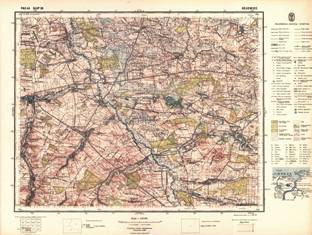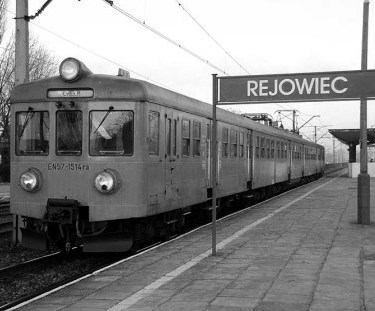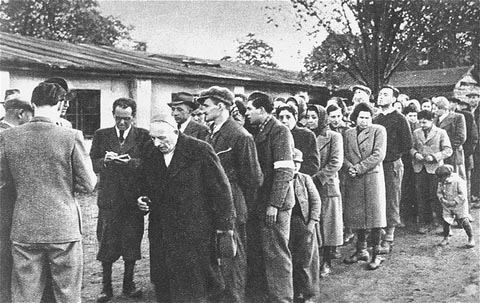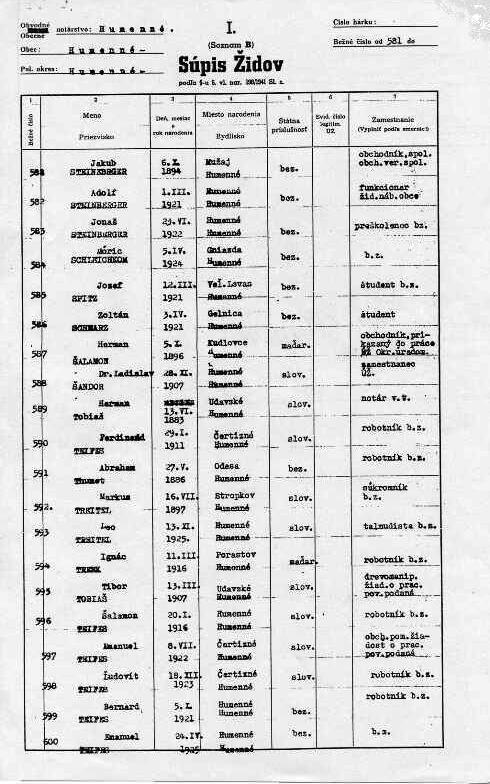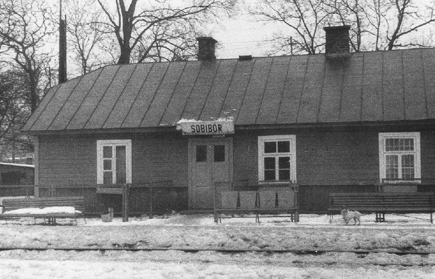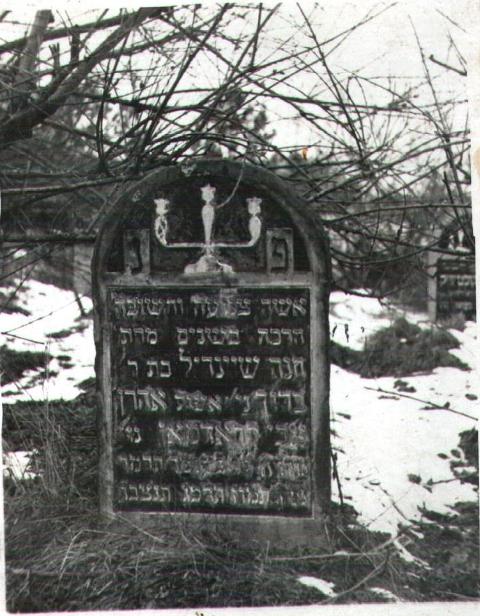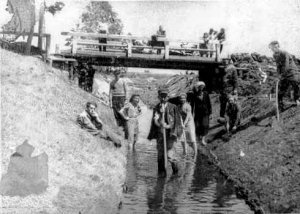Holocaust Education & Archive Research Team |
|
Occupation German Occupation of Europe Timeline
-
[The Occupied Nations]
Poland Austria Belgium Bulgaria Denmark France Germany Greece Hungary Italy Luxembourg The Netherlands Norway Romania Slovakia Soviet Union Sudetenland |
|||||
|
The Rejowiec Transit Ghetto Transit stop for the murder of Slovak Jews
Rejowiec in the district of Chelm, acquired municipal rights during the 16th Century and became famous thanks to Mikolaj Rej, a distinguished poet of the Polish Renaissance.
At the end of the 16th Century Rejowiec was populated mostly by Jews, and by the 20th Century the Jews accounted for eighty percent of its population. Before the Second World War commenced in September 1939 there were approximately 2,000 Jews in Rejowiec.
These were mostly poor Orthodox and Hassidic Jews, and these witnessed the arrival of the German Army in Rejowiec, but this stay was short lived as the Soviet Army occupied the town. However, this occupation was only temporary and the Germans returned in October 1939.
In February 1941 the German Police committed a sacrilegious act in the local prayer house, ordering the Jews to take the Torah scrolls and holy books outside and setting them on fire. The Jews were ordered to dance around the flames.
Soon after the synagogue and the prayer house were destroyed and all the Jews were removed from the centre of the town to the outskirts, later also during 1941 the Germans deported 1300 Jews from Lublin and Krakow into already overcrowded accommodation.
On the 7 April 1942 the Nazis gathered about 2,000 Jews and drove them like cattle to the railway station. Many elderly people and children who could not keep up were murdered on the way to the station.
This transport went to the newly constructed death camp at Sobibor, which was some 70 kilometres from Rejowiec. Once the Polish Jews had been transported to certain death, over 5,000 Czech and Slovak Jews filled their place, thus turning Rejowiec into another transit ghetto in the Lublin Region.
One unknown survivor who was deported from Slovakia managed to write to their local Judenrat via the Polish Underground about one such deportation and this is covered in a separate article.
In the summer of 1942 German and Ukrainian policemen accused the local Jewish community of killing one of their officer’s, and in retaliation several dozen Jews were locked in their homes and massacred with grenades.
During the first week of October 1942, the camp authorities resume mass murder operations in the gas chambers of Sobibor with the arrival of more than 24,000 Slovak Jews between October 8 and October 20 from the transit camp-ghetto Izbica in the Lublin District of the Generalgouvernement.
The camp authorities kill virtually all of the deportees upon arrival in reconstructed and newly added gas chambers, completed during the two month lull in transports to Sobibor.
The improvements in capacity
enable the camp authorities to kill up to 1,300 people at a time. Newly
constructed as well was a narrow railway trolley from the reception platform
to the burial pits in order to facilitate the transfer of the sick, the
dead, and those unable to walk directly to the open ovens. Those still alive after this
journey are shot by the SS staff or the Trawniki-trained guards. Facts Reported by a Jew Deported from Slovakia to Poland – Who has since Escaped and Returned
One unknown survivor who was deported from Slovakia managed to write to their local Judenrat via the Polish Underground about one such deportation and experiences in various camps:
“Our transport consisting of about 1,000 Jews was deported from Sabinov via Zilna, Cadoa directly to Poland. At the boundary we were told to line up and counted by the SD (Sicherheitsdienst) on the station, while the women were counted in the carriages.
Then we continued our journey for 3 or 4 days until we reached Rejowiec - Lubelski (district Lublin), where we left the carriages. During the whole of this time we suffered from thirst as we were given water on two occasions only, and no food at all, but we had left provided with plenty of provisions.
In Rejowiec we were received by the inspector of the water-works in Chelm, Ing. Holzheimer, the SA district commander of the district and 9 members of the Jewish OD (Ordnungsdienst), in Rejowiec, with their senior and head, Kessler, the eldest of the Jewish community, who helped us.
On the next day, May 27, two transports of a size similar to ours arrived from Stropkov and Humenne, so that we were then altogether 3,000 Slovakian Jews. On Chol Hamoed Pessach the Rejowiec Jews were deported, so that we found only about 3,000 Rejowiec Jews still in the Ghetto, as well as 60 Jews from the Protectorate, and some women from Nitra (Slovakia).
As lodgings we got the houses formerly belonging to Jews, but as there was a scarcity of lodgings, 20 to 25 people had to squeeze into a room of 3 by 4 metres. For eight days nobody watched or cared for us, and there was a terrible confusion.
We were given no food and of the valuable provisions which we had got from the UZ, at Zilina, the best portion, mostly spices was taken away from us, and the remainder stored in the schools. After a fortnight, when the food was completely spoilt and unfit for consumption, it was given back to us.
After a while the 3,000 Slovakian Jews were asked to apply for swamp-draining work, but only strong men, (fathers of more than 3 children were excluded), were admitted, altogether 450 men went to work. Those people received 250 grams of bread daily, a thin barley-groats soup for lunch, and a black “coffee” for supper.
Another 500 to 600 young people were ordered to the nearby camps like Sawin, Sajocice and Chelm (where there was an SA formation in charge), without consideration of their families. Those people were selected by the Jewish OD who accepted bribes.
The Jewish Council consisted of mixed elements; the unselfish help received from Mrs Forbeth, and Mrs Femes from Nitra (Slovakia) deserves special mention, but the same cannot be said about a certain Mrs Kaufmann and Mrs Singer (reported to be sisters), who also came from Nitra.
Nobody cared or provided for the remaining 2,000 Slovak Jews. But after 3 or 4 weeks the Jewish Council in Chelm founded a communal kitchen, which provided the Jews with a plate of soup for 50 groszy. The head of the Jewish council of Chelm at that time was a very honest and respectable Jew named Fraenkel, who was later shot together with his family.
Due to insufficient food and impossible sanitary conditions, many cases of typhus, dysentery and other epidemics occurred and caused many deaths among the older people.
One evening a drunk Polish policeman came into the house of Dr Grossman (Sabinov), who had just returned from a patient, and ordered the doctor to give him his wrist watch. A dispute followed during which the Policeman threatened the doctor, with his gun, and a free fight was the consequence of the doctor offering resistance.
The Jewish OD and Jews from the neighbourhood were called in to help, and the policeman was given back his gun, which he used to fire 3 alarm shots. The Polish police appeared at once, and arrested all inhabitants of Dr Grossmann’s house and 24 men from the neighbourhood, among whom there were 5 members of the OD.
Dr Grossmann tried to escape, was injured and subsequently shot. The 24 arrested people were put to death the next day for attempting a “communist revolt.” Among these were Mr Perlstein and his wife (Sabinov), Mrs Grossmann and his daughter (Sabinov), Mr Rosin (Humenne), Mr Moskovits (former bank clerk from Humenne), Mr Berliner (Humenne), Mr Klein and his son Michalany, Mr Appel, Siegmund (Sabinov, deaf and dumb), 5 members of the OD of Brunn, among them Reiss and Kessler.
On August 9, 1942, German police suddenly ordered a general line-up, the entire Jewish population, including the Jews of the ghetto as well as the labour camp, all together about 2,700 people, had to line up on the main square before the school with their luggage.
All those who had not been able to obey the order owing to illness or exhaustion were shot in their quarters.
The inmates of the Jewish hospital met with the same fate, among them Dr Sebok from Sabinov who had typhoid fever. About 10 o’clock the older people, who were too tired to hold their bags any longer and had set them down to sit on them, were shot in the neck from behind by SS men: 30 to 40 persons were killed in this manner.
Orders were then given to march, women walking in front. The physician Dr Birkenfeld brought up the rear, refusing to relinquish this most dangerous post because he considered it his duty as a doctor.
After only a few hundred feet, a salvo from rifles and automatic pistols coming from our left decimated our ranks, among those killed then were:
I was later told in Krychow by a former member of the Jewish Council (Judenrat) of Rejowiec, a Polish Jew named Holzblatt, who somehow escaped at that occasion - that during this massacre 700 Jews lost their lives.
At Rejowiec only a small number of workers of the nearby sugar factory remained, who, as I have learnt since, were later brought to Trawniki to cut peat. Among these were:
We were taken over at Rejowiec railway station by the so-called “Black Ukrainians.” There we were squeezed into waiting cattle trucks, 120 to 150 persons per truck, without previous registration. The doors were then closed from the outside, and the trucks were left standing at the station till 8pm.
25 men were once let out to gather the abandoned pieces of luggage and load them into the trucks. They were baited and maltreated by the “Black Ukrainians.”
It was August and unbearably hot in the trucks, and we were without water or air, but just stood body to body without any room for the slightest movement. 150 persons, of whom 20 were in my own truck, died there and then from suffocation, among them sturdy young men like:
We arrived at Sobibor shortly past midnight, where SS men with nagaikas (horse whips) received us. There at last we got a little water, though no food. We were subsequently lined up in a pine alley, divided by sexes, and twenty- five men were told to fall out to clear luggage and corpses out of the trucks.
We never saw these men again. In the morning we saw most of the women move in ranks of four to a yard some distance away. At 8am the SS lieutenant came to us and told all men who had previously worked at draining swamps to fall out.
About 100 men and 50 women stepped forward, 155 in all, to whom the lieutenant remarked cryptically; “You are born anew.” From the remaining group, mechanics, locksmiths and watchmakers were separated, while the rest had to follow the women to the yard in the distance and shared their fate.
Our group of 155 was brought to Osowa, where we spent one night. We were very well received and fed there by the Jewish organisation. At Osowa there were about 500 German and Czech Jews, Jewish Ghetto Police accompanied us to Krychow, on the way there we passed the farm of Hanak, where about 100 Jewish girls were employed for the threshing.
They were relatively well off there. Krychow is a penal camp erected by the former Polish Government in a swampy region. By now the neighbourhood has been fairly well drained by Jewish labour.
At the time of our arrival about 1,200 men and women were kept there, of whom about 400 were Czechs, 200 Slovaks, the remainder Poles, living conditions were indescribable: 200 people each lived in brick barracks 60 by 4 metres, there were neither straw nor covers or rugs of any kind, no washing accommodation, only indescribable and incredible filth and vermin.
We were literally covered with lice, and there was nothing we could do about it. Our diet consisted of 150 grains of bread, soup of cabbage leaves without fat or salt and black coffee. We knew from experience that such a diet leads to death from malnutrition within 6 weeks.
After a short time most of us had swollen faces and feet, and either typhoid fever or dysentery or both. We had at least a dozen deaths every day. Of the group of 155 with which I had come, 60 died there. The work was not particularly strenuous, but it was too hard for us in our exhausted state. Nevertheless, the doctor had no right to acknowledge an illness, and people were sent to work with a temperature of 39 degree c.
Anyhow, treatment in the hospital consisted of dumping people there: no medicine, or special food was given them, and survival was purely dependent upon strength of constitution, and money to some extent, because at high prices medicaments were obtainable. Most of us did not have money.
On October 16 we were told that a certain proportion of workers was to be sent to the “Jewish City” of Wlodawa on the Bug, 25 km from Krychow. For this deportation elderly and weak persons, not well fitted for work and the children were chosen. The hospital was cleared too, and the inmates sent to Wlodawa. These people were sent without baggage and bare-footed, because the rubber boots used for the draining work belonged to the camp, and they were not allowed to fetch their own shoes.
Four days after they arrived at Wlodawa, the entire Jewish population there was deported to Sobibor (annihilation camp). Some time after this, the inmates of the camps of Ujazdow and Hansk were brought to us for the winter. This influx made living conditions quite unbearable. Then, on December 9 we were suddenly told that a general deportation was imminent.
100 persons were selected - later an additional 10 were allowed to stay on, all the rest were carried away. Among those remaining there were some women and girls from Nitra and thereabouts:
And some German and Czech women and girls, of the men from Slovakia I alone remained with two men from Bohemia:
The remaining group owed much to Briska Taussig from Nitra, who had succeeded in establishing herself in a privileged position with the administration, and used it to give as much help as she could. It was due to her that so many girls could be retained in the camp.
Early in 1943 there was a new influx of Polish Jews into the camp. In June 1943 the camps of Osowa, Sawin, Sajczyce and Luta were liquidated, and the survivors came to us, swelling our numbers to 533.
At Hansk there were a further 100 to 110 women and five men, among those who came to us from Sawin were:
Starting from 1943 conditions at Krychow improved considerably. After December 9 1942, we got a bread ration of 400 to 500 grams per day and a thick potato soup at noon.
We were given good iron bedsteads, and washing accommodation. With the improvement of sanitary conditions the state of health much improved, and only three of the 110 people who had originally remained, died since then, as a result of the prevailing conditions. Buchler, from Bratislava- Nitra, former owner of a Vienna café, related to Attorney Fodor of Nitra, who died of cancer, Donath Prievidza, 55 years of age. Mrs Hand from Vienna (who had a daughter of 18 at Krychow).
Three other sick people were shot by the deputy camp commander, when the commander was on leave. They were: Hopkovitz from Stropkov, a former clerk in the firm of Kulik, and 2 Polish Jews.
After the enlargement of the camp in March, food conditions became worse again, the bread ration was lowered to 150 grams per day and a fat less vegetable soup was given for lunch.
In April 1943, we heard rumours about Dutch and Belgian Jews coming to us, which were confirmed by the camp authorities. They did not come, but I heard the following about their fate:
The transports from Belgium and Holland arrived in very good condition, as they travelled in 2nd class carriages (unlike us) and at the bigger stations received food and white bread.
Some older and weaker persons were sent back to Holland and Belgium under the pretext that they were unfit for the work which was the official justification given to the horrified Dutch and Belgian public for the deportations.
At first, there were reports that some proportion was actually detached for work, as had been done in other countries, but in reality, the SD (Sicherheitsdienst – Security Service of the Gestapo) released no one, and all were destroyed at Sobibor.
In the neighbourhood of Sobibor the sky is always lit up at night by reflected fire, and there is an all-pervading stench of burnt hair. The population asserts, and various signs confirm that the corpses of Jews formerly slaughtered by electricity or poison gas, and buried, are now disinterred and burned, in order to baffle any attempt at tracing the murders.
In 1942 escapes from camps were punished by brutal reprisals levelled against the remaining inmates. The fugitives were mostly Polish Jews who were acquainted with local conditions. They fled to the forests and formed bands which lived by robbery. Of late, punishment for desertion has fallen only upon the deserter himself, if he was caught.
Then the camp of Sawin still existed, Dr Sobel from Pecovska, Nova-Ves, and Peinere, tried to escape. Both were caught, Dr Sobel was executed, Peinere was brought back to camp, but succeeded in escaping once more, and he has not been heard of since. Similarly, Mr Lajos Klein escaped from Michalowce, his later history is unknown.
According to information I have received, about 8,000 Jews were employed at Lublin – Majdanek on draining, water supply and building work. They were reported to be wearing convicts’ uniform.
From Armin Goldstein of Sabinov, I heard that Mano Goldberg died at Lublin-Majdanek.
The following SS and SA functionaries have taken a particularly prominent part in the slaughter of Jews:
Chiefly responsible for the whole course of events in this region:
Ing (Engineer) Holzheimer Chief of Water Supply Administration at Chelm
Slovakia August 17, 1943
Sources:
From Lublin to Belzec, by Robert Kuwalek, published AD REM
The Jews of Czechoslovakia. Avigdor Dagan, Jewish Publication Society, Philadelphia, 1984 Holocaust Historical Society. Encyclopedia of the Holocaust, Israel Gutman, Macmillan Publishing Company, New York, 1990 Belzec, Sobibor and Treblinka by Yitzhak Arad – Indiana University Press Yad Vashem OMDA Archives & Website
Copyright Robert Kuwalek, Chris Webb, Branik Ceslav, & Carmelo Lisciotto H.E.A.R.T 2009
|
